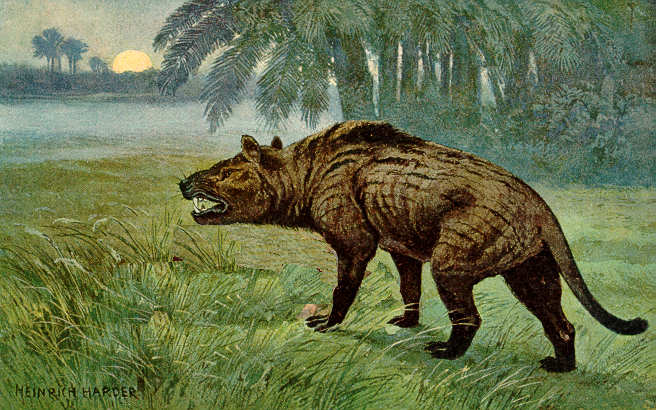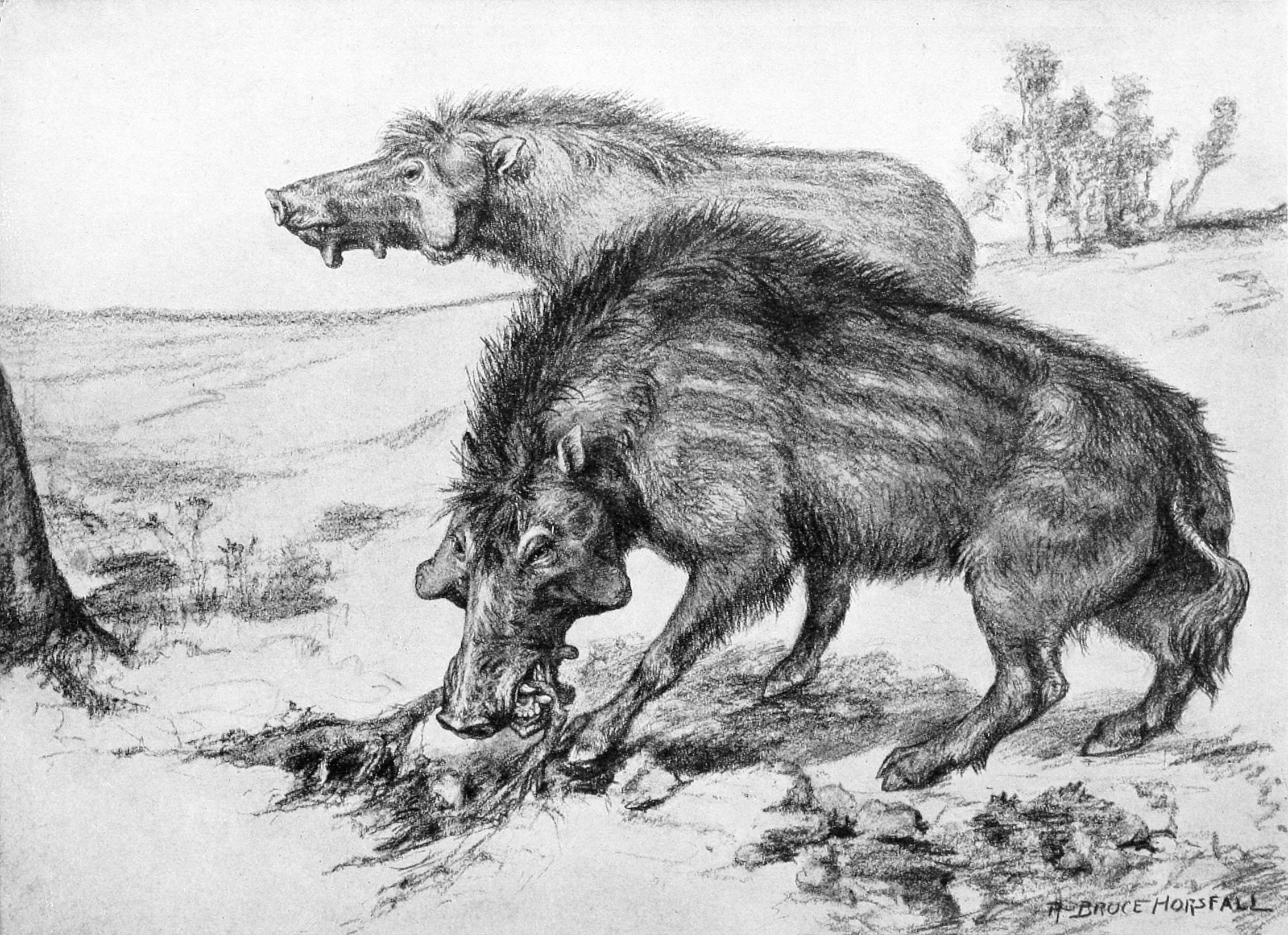|
Prehistoric Predators
''Prehistoric Predators'' is a 2007 National Geographic Channel program based on different predators that lived in the Cenozoic era, including ''Smilodon'' and '' C. megalodon''. The series investigated how such beasts hunted and fought other creatures, and what drove them to extinction. Featured animals *Pleistocene: 1.8 million-10,000 years ago :North America: :''Smilodon fatalis'', dire wolf, short-faced bear, American lion, ''Bison antiquus'', Mexican horse, Columbian mammoth, ''Megalonyx'', gray wolf (cameo), grizzly bear (cameo), early humans *Miocene-Pliocene: 15-3 million years ago :South America, North America: :''Kelenken'', ''Parapropalaehoplophorus'', ''Homalodotherium'', ''Titanis'', ''Canis edwardii'', '' Smilodon gracilis'', ''Neohipparion'' *Miocene-Pleistocene: 20-2 million years ago :The Atlantic: :'' C. megalodon'', ''Cetotherium'', '' Squalodon'', dugong, great white shark (cameo), green sea turtle (cameo) *Oligocene-Miocene: 32-19 million years ago :North ... [...More Info...] [...Related Items...] OR: [Wikipedia] [Google] [Baidu] |
Television Documentary
Television documentaries are televised media productions that screen documentaries. Television documentaries exist either as a television documentary series or as a television documentary film. * Television documentary series, sometimes called docuseries, are television series screened within an ordered collection of two or more televised episodes. * Television documentary films exist as a singular documentary film to be broadcast via a documentary channel or a News broadcasting, news-related channel. Occasionally, documentary films that were initially intended for televised broadcasting may be screened in a Movie theater, cinema. Documentary television rose to prominence during the 1940s, spawning from earlier cinematic documentary filmmaking ventures. Early production techniques were highly inefficient compared to modern recording methods. Early television documentaries typically featured historical, wartime, investigative or event-related subject matter. Contemporary televisio ... [...More Info...] [...Related Items...] OR: [Wikipedia] [Google] [Baidu] |
Kelenken
''Kelenken'' is a genus of phorusrhacid ("terror bird"), an extinct group of large, predatory birds, which lived in what is now Argentina in the middle Miocene about 15 million years ago. The only known specimen was discovered by high school student Guillermo Aguirre-Zabala in Comallo, in the region of Patagonia, and was made the holotype of the new genus and species ''Kelenken guillermoi'' in 2007. The genus name references a spirit in Tehuelche people, Tehuelche mythology, and the Specific name (zoology), specific name honors the discoverer. The holotype consists of one of the most complete skulls known of a large phorusrhacid, as well as a tarsometatarsus lower leg bone and a Phalanx bone, phalanx toe bone. The discovery of ''Kelenken'' clarified the anatomy of large phorusrhacids, as these were previously much less well known. The closest living relatives of the phorusrhacids are the seriemas. ''Kelenken'' was found to belong in the subfamily Phorusrhacinae, along with for exa ... [...More Info...] [...Related Items...] OR: [Wikipedia] [Google] [Baidu] |
Hyaenodon
''Hyaenodon'' ("hyena-tooth") is an Extinction (biology), extinct genus of Carnivore, carnivorous Placentalia, placental mammals from extinct tribe Hyaenodontini within extinct subfamily Hyaenodontinae (in extinct Family (biology), family Hyaenodontidae),Malcolm C. McKenna, Susan K. Bell (1997)"Classification of Mammals: Above the Species Level" Columbia University Press, New York, 631 pages. that lived in Eurasia and North America from the early Eocene to the early Miocene. Classification and phylogeny Taxonomy Description The skull of ''Hyaenodon'' was long with a narrow snout—much larger in relation to the length of the skull than in Canidae, canine carnivores, for instance. The neck was shorter than the skull, while the body was long and robust and terminated in a long tail. Compared to the larger (but not closely related) ''Hyainailouros'', the dentition of ''Hyaenodon'' was geared more towards shearing meat and less towards bone crushing. Some species of this ... [...More Info...] [...Related Items...] OR: [Wikipedia] [Google] [Baidu] |
Archaeotherium
''Archaeotherium'' (, meaning "ancient beast") is an extinct genus of entelodont artiodactyl endemic to North America during the Eocene and Oligocene epochs (35–28 mya). ''Archaeotherium'' fossils are most common in the White River Formation of the Great Plains, but they have also been found in the John Day Basin of Oregon and the Trans-Pecos area of Texas. ''Archaeotherium'''s fossils come from North America, between the Priabonian and Rupelian stages of the Eocene and Oligocene (35–28 million years ago). Up to fifteen species of ''Archaeotherium'' have been identified, which are divided into three subgenera. One contains the type species, ''A. mortoni'', among others; another contains very large taxa formerly named ''Megachoerus'' and ''Pelonax''; and the last contains ''A. calkinsi''. ''Archaeotherium'' was distinguished from most entelodonts by having an unusually long snout and large jugal flanges, extensions of the zygomatic arches that are characteristic of the group ... [...More Info...] [...Related Items...] OR: [Wikipedia] [Google] [Baidu] |
Green Sea Turtle
The green sea turtle (''Chelonia mydas''), also known as the green turtle, black (sea) turtle or Pacific green turtle, is a species of large sea turtle of the family Cheloniidae. It is the only species in the genus ''Chelonia''. Its range extends throughout tropical and subtropical seas around the world, with two distinct populations in the Atlantic and Pacific Oceans, but it is also found in the Indian Ocean. The common name refers to the usually green fat found beneath its carapace, due to its diet strictly being seagrass, not to the color of its carapace, which is olive to black. The dorsoventrally flattened body of ''C. mydas'' is covered by a large, teardrop-shaped carapace; it has a pair of large, paddle-like flippers. It is usually lightly colored, although in the eastern Pacific populations, parts of the carapace can be almost black. Unlike other members of its family, such as the hawksbill sea turtle, ''C. mydas'' is mostly herbivorous. The adults usually inhabit ... [...More Info...] [...Related Items...] OR: [Wikipedia] [Google] [Baidu] |
Great White Shark
The great white shark (''Carcharodon carcharias''), also known as the white shark, white pointer, or simply great white, is a species of large Lamniformes, mackerel shark which can be found in the coastal surface waters of all the major oceans. It is the only known surviving species of its genus ''Carcharodon''. The great white shark is notable for its size, with the largest preserved female specimen measuring in length and around in weight at maturity. However, most are smaller; males measure , and females measure on average. According to a 2014 study, the lifespan of great white sharks is estimated to be as long as 70 years or more, well above previous estimates, making it one of the longest lived Chondrichthyes, cartilaginous fishes currently known. According to the same study, male great white sharks take 26 years to reach sexual maturity, while the females take 33 years to be ready to produce offspring. Great white sharks can swim at speeds of 25 km/h (16 mph ... [...More Info...] [...Related Items...] OR: [Wikipedia] [Google] [Baidu] |
Dugong
The dugong (; ''Dugong dugon'') is a marine mammal. It is one of four living species of the order Sirenia, which also includes three species of manatees. It is the only living representative of the once-diverse family Dugongidae; its closest modern relative, Steller's sea cow (''Hydrodamalis gigas''), was hunted to extinction in the 18th century. The dugong is the only sirenian in its range, which spans the waters of some 40 countries and territories throughout the Indo-West Pacific. The dugong is largely dependent on seagrass communities for subsistence and is thus restricted to the coastal habitats that support seagrass meadows, with the largest dugong concentrations typically occurring in wide, shallow, protected areas such as bays, mangrove channels, the waters of large inshore islands, and inter-reefal waters. The northern waters of Australia between Shark Bay and Moreton Bay are believed to be the dugong's contemporary stronghold. Like all modern sirenians, the d ... [...More Info...] [...Related Items...] OR: [Wikipedia] [Google] [Baidu] |
Squalodon
''Squalodon'' is an extinct genus of whales of the Oligocene and Miocene epochs, belonging to the family Squalodontidae. Named by Jean-Pierre Sylvestre de Grateloup in 1840, it was originally believed to be an iguanodontid dinosaur but has since been reclassified. The name ''Squalodon'' comes from ''Squalus'', a genus of shark. As a result, its name means "shark tooth". Its closest modern relatives are the 2 species of the genus South Asian river dolphin, Platanista ( the Ganges river dolphin and Indus river dolphin). Description Species of ''Squalodon'' are odontocetes that lived during the late Oligocene into the middle Miocene, about 28 to 15 million years ago. The genus ''Squalodon'' belongs to the order Odontoceti, the toothed whales. Their name is derived from the term ''Wiktionary:squalus#Noun, Squalus'' because their cheek teeth were thought to resemble the teeth of a Spurdog, ''Squalus'' shark. The largest species, ''Squalodon whitmorei'', reached up to 5.5 meters in ... [...More Info...] [...Related Items...] OR: [Wikipedia] [Google] [Baidu] |






